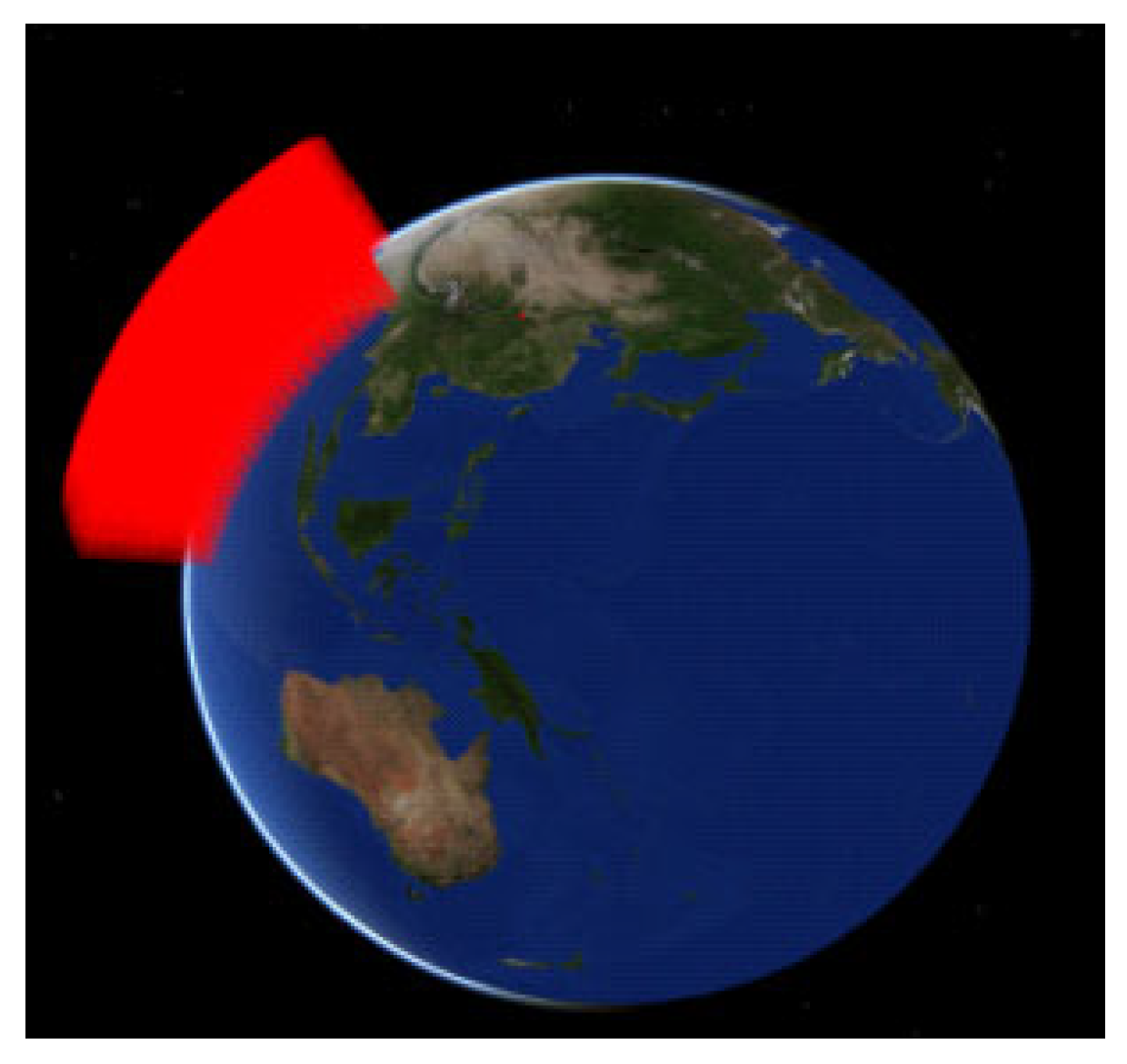Correction: Liu et al. UAV Path Planning in Threat Environment: A*-APF Algorithm for Spatio-Temporal Grid Optimization. Drones 2025, 9, 661

- Coding length and level identification. The coding length for each dimension is fixed at 32 binary digits. For a given level (N2 = 13), the effective number of bits is 16. Therefore, the latter 16 bits of the latitude coding (the level identification code element part) consist of 1 bit of “0” (indicating the end of the level) and 15 bits of “1” (padding bits). Similarly, the effective number of bits for the height level N3 = 16 is 18.
- Encoding Latitude and Longitude. For latitude (34°24′58.379″ N), the first code element: the Northern Hemisphere (N) is identified as “0”; the degree value (34°) is converted to a 9-bit binary number “000100010” (with leading zeros to make 9 bits); the minute value (24′) is converted to a 7-bit binary number “0101100”; the second value (58″) is converted to a 7-bit binary number “1110011”; the fractional part of the second (0.379″) is converted to an 8-bit binary number “01100001”. Combining these parts and adding a 1-bit level identifier (the first “0” in the last 16 bits mentioned in Step 1), we obtain the complete 32-bit latitude code “0001000100101100111001101100001”. Based on an effective bit length of 16, the latitude code under N2 = 13 is “00010001001011000111111111111111”. Similarly, the longitude (109°3′41.260″ E) is encoded as “00110110100000110111111111111111111”.
- Two-dimensional plane encoding. The obtained 32-bit latitude encoding and 32-bit longitude encoding are combined using Morton ordering to generate a unique 64-bit two-dimensional plane encoding. The result in this example is “0000011100010110010010001010010100111111111111111111111111111111”.
- Height encoding. Based on an effective bit length of 18, the height encoding under N3 = 16 is “00000001000110000001111111111111”. See Figure 3 for a detailed diagram of the encoding process.Figure 3. Three-dimensional coding conversion example.
Reference
- Liu, L.; Ru, L.; Wang, W.; Xi, H.; Zhu, R.; Li, S.; Zhang, Z. UAV Path Planning in Threat Environment: A*-APF Algorithm for Spatio-Temporal Grid Optimization. Drones 2025, 9, 661. [Google Scholar] [CrossRef]
Disclaimer/Publisher’s Note: The statements, opinions and data contained in all publications are solely those of the individual author(s) and contributor(s) and not of MDPI and/or the editor(s). MDPI and/or the editor(s) disclaim responsibility for any injury to people or property resulting from any ideas, methods, instructions or products referred to in the content. |
© 2025 by the authors. Licensee MDPI, Basel, Switzerland. This article is an open access article distributed under the terms and conditions of the Creative Commons Attribution (CC BY) license (https://creativecommons.org/licenses/by/4.0/).
Share and Cite
Liu, L.; Ru, L.; Wang, W.; Xi, H.; Zhu, R.; Li, S.; Zhang, Z. Correction: Liu et al. UAV Path Planning in Threat Environment: A*-APF Algorithm for Spatio-Temporal Grid Optimization. Drones 2025, 9, 661. Drones 2025, 9, 713. https://doi.org/10.3390/drones9100713
Liu L, Ru L, Wang W, Xi H, Zhu R, Li S, Zhang Z. Correction: Liu et al. UAV Path Planning in Threat Environment: A*-APF Algorithm for Spatio-Temporal Grid Optimization. Drones 2025, 9, 661. Drones. 2025; 9(10):713. https://doi.org/10.3390/drones9100713
Chicago/Turabian StyleLiu, Longhao, Le Ru, Wenfei Wang, Hailong Xi, Rui Zhu, Shiliang Li, and Zhenghao Zhang. 2025. "Correction: Liu et al. UAV Path Planning in Threat Environment: A*-APF Algorithm for Spatio-Temporal Grid Optimization. Drones 2025, 9, 661" Drones 9, no. 10: 713. https://doi.org/10.3390/drones9100713
APA StyleLiu, L., Ru, L., Wang, W., Xi, H., Zhu, R., Li, S., & Zhang, Z. (2025). Correction: Liu et al. UAV Path Planning in Threat Environment: A*-APF Algorithm for Spatio-Temporal Grid Optimization. Drones 2025, 9, 661. Drones, 9(10), 713. https://doi.org/10.3390/drones9100713





